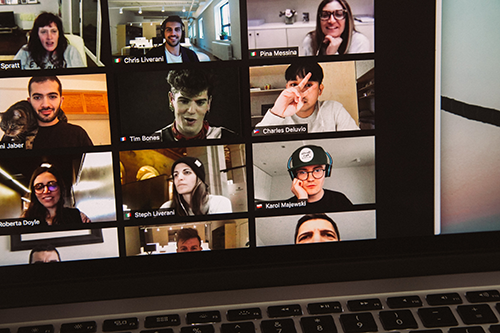Remote Work and Designing the Gender Wage Gap Online Data Narrative
Laura Dahl, PhD, UX Researcher
May 26, 2021

Recently, I was tasked with designing the data narrative for the upcoming gender wage gap report. This report is important enough, and enough people want to see it, that I have been asked to hustle my work.
Because the reports that UDRC researchers create are used in the decision-making of public policy, I wanted to design a highly informative and usable narrative for our website. This goal meant I needed to design the narrative and make quick iterations based on quality feedback from team members. However, we are all working remotely, which can be challenging for User Experience (UX) design work.
To accomplish this task, I collaborated with the primary researcher, Karen Tao, to create the design and get it to where we need it. I helped her with aspects of the full report while also working on the web-based narrative design. We met several times over teleconferencing and hammered out the summary text and design of graphs.
After meeting through teleconferencing a couple of times, the bulk of our shared work took place through an online folder. We communicated feedback and updates through email and our chat-based messaging platform. These shared communication channels also allowed UDRC leadership to give feedback and ask questions. As I am in the final days of preparing the online narrative, we continue to communicate and provide updates over our digital communication platforms.
Overall, our collaboration worked because we had almost daily check-ins. Also, we regularly kept each other aware of our work and worked through details when we talked during weekly team meetings or through online communication channels.
I have been remote working for the last three years, and I have some advice for UX work, including over-communicating and over-sharing your work.
Over-Communicate your Work
Communication is the top issue when working remotely. I recommend communicating more than might seem necessary. Remote work requires two types of communication: synchronous and asynchronous communication.
Synchronous Communication
Synchronous communication means talking together at the same time and with all parties “present.” Plan and set aside regular times for synchronous discussions, collaboration, and team updates.
- Regular stand-up meetings are an opportunity for the team to discuss current progress, ongoing questions, and blockers.
- Iterative planning and working meetings should be scheduled at key moments during the project to work through issues and make decisions. As you need to collaborate on your project, plan an hour or two in an online meeting to share screens and work together on the issues.
Asynchronous Communication
Often, remote work necessitates asynchronous communication where team members send messages to others who may not be “present” at the same time.
- Use a chat app to see when people are available on their computers and send information, questions, and files. If team members are available and “present,” chat apps often turn asynchronous to synchronous communication where people can answer questions and quickly make decisions. Otherwise, contacting a team member in chat allows for a message to notify the recipient when they return to their computer or have finished a meeting. I have found these communication platforms a great way to communicate and build rapport with team members while working remotely.
- Email is another great way to communicate while working remotely. I prefer email communication when I need to save, categorize, or archive the information or attached documents. Email allows for a more stable way to communicate and follow a thread.
Over-Share your Work
Remote work means that team members are not readily aware of your day-to-day work. In other words, they can no longer walk over to your desk to discuss what you are working on that day. Additionally, your team leaders will want to know what you are working on and any roadblocks that you might have.
Other team members are busy with their own work, so they might not remember where you have shared your work for collaboration purposes. I recommend making your own work easily accessible by saving it on a cloud drive and in file formats that others can open. You might have to send the link to your shared folder several times, so that team members remember how to access your work. For example, I created design assets in Adobe XD for the Gender Wage Gap narrative. Saving my design files in Adobe XD format and sharing them in a cloud-based folder allowed all team members to open my work and give feedback.
Overall, remote work is a positive experience for me, and I receive the collaboration and feedback I need from the wonderful people in UDRC. Through over-communicating and over-sharing my work, I have been able to successfully work through the complexities of design thinking and user experience while working remotely.